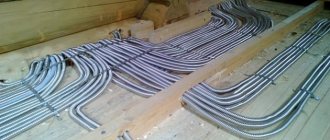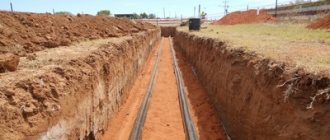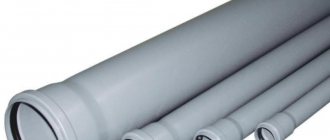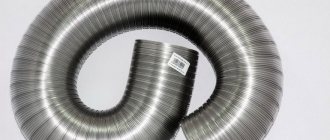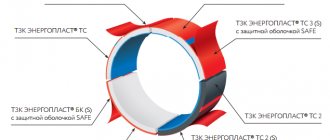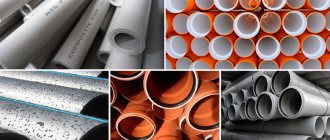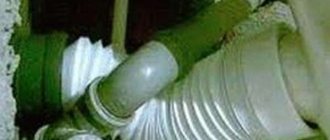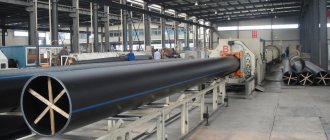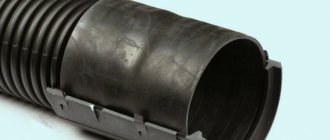Electrician in the house
Encyclopedia about electricity from A to Z
Masters catalog
Find the best master or company in your city
How did we manage without electric corrugations before?
Today, when laying wiring or repairing it, it is recommended to additionally “pack” all wires in a protective sheath, which is a corrugated tube for the cable. The most common version of such protection is a round tube with a ribbed structure, due to which the product has a certain flexibility.
In this article we will look at how protective corrugated cable pipes are selected depending on their types and the purposes pursued by the installer.
- Purpose of corrugation
- Types of corrugation Differences in design
- Materials
- Corrugated pipe sizes
Why do you need corrugation?
Corrugation is a corrosion-resistant, hollow special ribbed pipe used for laying wires and cables in various environments and conditions. Depending on the type, it is not exposed to external factors, water, etc. Special corrugated pipes are used for laying various wires and cables:
- underground (to provide a hard shell and protection from groundwater, rotting, damage by animals and rodents);
- in wooden, frame and other combustible walls or laid under fire-hazardous finishing materials such as lining, wooden panels and others (for protection against fire and unintentional damage to the cable);
- under the floor covering (to protect against compression by concrete or other damage);
- outside buildings (to protect against illegal actions of third parties and atmospheric phenomena, including exposure to ultraviolet radiation and high temperatures in the summer).
Important! Fireproof types of corrugation, when a fire occurs, begin to release special substances that prevent the spread of fire, as a result of which the fire quickly dies out.
Protected metal corrugated hose Source tepluydim.com.ua
Thanks to proper work with corrugated pipes, when it becomes necessary to replace the wires with new ones, this can be done without dismantling the already installed corrugated hoses.
A special broach is used for this.
Disadvantages and advantages of metal corrugation
Cable laying in a corrugated pipe
To ensure that electrical equipment does not cause problems due to cable wear, metal corrugation for laying is simply irreplaceable. Its undoubted advantages include the following significant points:
- long service life (in the absence of additional aggressive factors - up to 50 years);
- providing effective protection against rodents and various types of mechanical damage;
- high environmental friendliness;
- non-flammability;
- lack of sensitivity to atmospheric influences;
- providing additional protection against electric shock;
- light weight.
There are not many disadvantages to this electrical installation product. Among them may be named:
- increase in installation time for electrical wiring;
- higher cost of cable installation.
Considering the fact that the advantages of metal corrugation clearly prevail over the disadvantages, it is not surprising that it is so widely used.
Kinds
Corrugations for wires are available in several dozen types. The articles of this special product differ in color, material of manufacture, diameter, load-bearing capacity, and wall thickness. Let's look at the types of corrugated pipes:
By material
- Polyvinyl chloride (PVC). Used as non-flammable and inexpensive cable protection products that must be located away from exposure to sunlight, water and ultraviolet radiation.
- Metal (metal hoses). Protect from mechanical damage, fires, corrosive and other active substances.
- Polyethylene, polypropylene (PPR). They can be intended for installation under conditions of high (HPE) or low (HDPE) pressure, withstand temperature influences from – 40 ° C to + 45 ° C, as well as exposure to acids, alkalis, ultraviolet rays and oils (PPR pipes are self-extinguishing and usually are painted gray during manufacturing, HDPE – orange or black).
Polyethylene corrugation Source elektro-svitidla.com
In terms of resistance to external influences
- Lightweight (wall thickness up to 320 N/5 cm², flexible, cannot withstand heavy loads) are laid in ceiling and wall plasterboard structures.
- Medium ones (wall thickness up to 750 N/5 cm²) can be placed in the grooves of room walls.
- Heavy (wall thickness up to 1250 N/5 cm², are inflexible) can withstand installation in concrete screeds, withstand exposure to moisture, dust and dirt.
- Reinforced super-heavy (the thickness of the walls of the metal corrugation for electrical wiring is more than 1250 N/5 cm², it consists of metal wires twisted in a spiral, covered with a plastic sheath) intended for installation outdoors or underground.
By number of layers
- Single-layer (may have different thicknesses).
- Double-layer (have two walls at once).
Metal corrugation, in turn, is divided into several subspecies. It can be made from stainless or galvanized steel; plastic or polymer material is used as a coating. Metal-polymer corrugated hose has the best user characteristics, as it maximally protects wires from water and dust.
This is interesting! Typically, red, blue and black polyethylene corrugated pipes are used for outdoor use and general purpose circuits, respectively, white ones are found in places where the Internet and electrical networks are laid, green ones are used for telephony, although this rule is not required to be observed.
Laying metal corrugation Source rusenergetics.ru
See also: Catalog of companies that specialize in electrical work of any complexity
The outer diameter of corrugated cable products can range from 16 mm to 87.5 mm, the inner diameter - from 5 mm to 78 mm. Also, the design of some corrugated pipes includes a probe that helps pull flexible wires through the sleeve.
According to GOST R IEC 61386, several types of corrugated hoses are distinguished: according to the degree of spread of the combustion process, and according to protection against corrosion. According to the rules of GOST 14254-2015, the degree of protection of corrugated pipes from penetration and exposure to solid particles and/or water is indicated according to the IP index. Corrugated highways are also divided into several types according to the temperature range at which they can be operated. When choosing a specific type of corrugation, a specialist must be guided by information about the use and location of the wiring being laid.
Laying in grooves Source uk-parkovaya.ru
For example, outdoors it is imperative to use a protected reinforced corrugated pipe, which resists the effects of mechanical, natural, and temperature factors and has an IP rating corresponding to the expected load.
Size
The thickness of the corrugated cable determines the number and thickness of wires that can be laid through such a protective sleeve. When a corrugated pipe is sold, it is marked in which the first number indicates the outer diameter, the second - the wall thickness. The diameter of the cable corrugation is indicated in the table:
This is how the thickness of the corrugation is determined (table, part 1) Source infocable.by
This is how the thickness of the corrugation is determined (table, part 2) Source infocable.by
Recommendations for installation work
This section will discuss some of the nuances associated with laying wiring and enclosing it in a corrugated pipe. This is necessary to know in order to simplify installation work.
Corrugated cable laying
There will be no special problems when placing the cable in a pipe equipped with a pulling string. The end of the wire (the connected bundle of wires) is simply twisted securely to one of the ends of the broach. Then this connecting node is tightly wrapped with electrical tape, creating a “fairing” that will not cling to the unevenness of the corrugation channel. After this, preferably in a straight section, you must carefully, without jerking, pull the pulling wire from the other side of the pipe until the cable appears from the hole. And then all that remains is to secure the wires to the corrugation with electrical tape from both one and the other end of the tube so that they do not “dive” inside again during installation work.
Having secured the cable to the broach, it is recommended to “ennoble” this connecting node with electrical tape so that it does not catch on the inner corrugated surface of the pipe.
If you purchased a corrugated cable without pulling it, then it is best to lay the cable into it with an assistant, while observing the following nuances:
- If several cables are pulled into corrugated insulation, they must be folded together along their entire length and secured with electrical tape rings every 400÷500 mm. If the cables are not rigid enough, they should be fixed even in increments of 300 mm.
- The end of one or more cables, with which they will be inserted into the pipe, must be wrapped approximately 100÷120 mm with electrical tape. This will make it easier to overcome obstacles inside the corrugation.
- If the cable is very flexible, then first a rigid wire is pulled into the pipe along its entire length, that is, in essence, the same stretch is done. Then a cable is attached to its end, and then - according to the scheme already discussed.
This illustration shows options for pulling the cable through a corrugated tube alone and with the assistance of an assistant.
Some craftsmen pull the cable through the corrugation after it has been secured to the surface of the wall or ceiling, or in a groove. When arranging electrical wiring in an apartment or house, the areas between distribution boxes, switches, socket groups, and lamps are small and, as a rule, straight, with a maximum of one or two smooth turns. Therefore, there should be no problems with pulling the cable through the corrugation. By the way, this approach can also be used when replacing a faulty cable with a new one, without opening the trim covering the wiring.
If large sections of wiring are being installed, for example, in outdoor conditions, then this method is unlikely to be applicable. That is, the best option would be to first lay the cable in the corrugation, and then secure it, for example, to a stretched cable.
How are corrugated pipes and wiring attached?
In different conditions, corrugated pipes are installed in different ways.
If the “air” wiring runs along the street, then the corrugation is suspended on a stretched metal cable.
- When installing external wiring stretched “over the air” into a separate building, the corrugation is most often secured to a cable stretched between buildings using plastic clamps. They are very convenient to use, and at first they reliably hold the corrugated tube together with the cable. However, under the influence of external factors (moisture, ultraviolet radiation, temperature changes), plastic clamps weaken and crack, losing their holding abilities. You have to replace them with new ones, or initially use other methods of fastening, for example, using twisted strips of tin clamps.
Despite the fact that the illustration shows gray PVC corrugation, the best option for the street would be to use a tube made of polyamide (dark gray), polypropylene (blue), metal or metal-polymer corrugation. These product options show higher resistance to aggressive weather conditions and temperature changes.
Prices for corrugated pipe
corrugated pipe
Plastic clips, which are traditionally used for fixing polypropylene or metal-plastic water pipes, are also excellent for fastening corrugations.
- If the wiring is supposed to be laid externally, secured to the wall or ceiling, then special clips made of plastic are often used for this purpose. Such fasteners are selected to match the diameter of the corrugated pipe. Clips can be secured to the surface with self-tapping screws or dowels. The type of fastening depends on the wall material or flow. Clips are installed in increments of 400÷500 mm.
When the clips are fixed to the surface, a corrugated tube is inserted into them one by one and pressed until it clicks.
A dowel-clamp and a dowel-pin for fastening the corrugation in the groove.
- If the wiring is planned to be embedded in the walls, then groove channels are cut into the surface under the corrugation with an angle grinder (“grinder”) and/or a hammer drill. The corrugated tube is secured in the grooves with special plastic dowel pins or dowel clamps.
Fastening the corrugation in the groove using a dowel-pin.
If such fasteners cannot be found, then you can use homemade fasteners - metal strips or even pieces of rigid wire, which are fastened with ordinary dowels. Another option - the corrugation laid in the pipes is simply fixed with “bloopers” of quick-hardening gypsum mortar or alabaster. However, ready-made clamps are more convenient, they are inexpensive, and greatly facilitate the work.
If a clamp is used, then a hole is drilled in the center of the groove in the right place into which the dowel is driven. Then the pipe is installed and secured with a tightening clamp.
In another option, after drilling the holes, a corrugation is laid, pins are put on it, the ends of which spontaneously connect. And all that remains is to carefully insert (knock) these folded ends into the hole. It is clear that the dowel-studs, in contrast to the more universal tightening clamp, must be selected according to the diameter of the corrugated pipe.
Option to secure wiring above a suspended ceiling - with hanger ties
- If the wiring is hidden by a suspended ceiling, the corrugation is fixed on hangers holding metal profiles.
When developing an electrical wiring diagram, you need to take into account some recommendations that will simplify the work:
- Electrical wiring should only have smooth turns, especially in cases where it is planned to install the cable in an already fixed corrugated pipe. If the pipe is installed together with the cable, the presence of smooth turns will allow, if necessary, to replace damaged wiring. To do this, the damaged cable is de-energized and pulled out of the corrugation, while a new one is installed.
- The length of the sections between connected points or boxes should not exceed 20÷25 meters, while the route can have no more than four turns.
If it is planned to lay several cables located in different insulating tubes, then they are mounted parallel to each other, making a minimum number of smooth turns. Installation in several tiers is strictly prohibited.
- There must be a distance of at least 3÷5 meters between two turns. If there is a need to shorten this section between turns, it is recommended to install a distribution box and change the direction of the cable using it.
The cable rotation can be done through the junction box.
- The angle of rotation of the corrugation together with the cable should not be less than 90 degrees, but it is better if it is larger.
- If it is intended to lay electrical wiring with a high load next to cables with low voltage, then they are placed in different corrugated pipes, which are mounted at a distance of at least 20 mm from each other. Their intersection can only take place at right angles.
These recommendations apply to the installation of electrical wiring indoors, outdoors by hanging it on a cable, as well as the underground version. When laying a long route, you should provide for the possibility of replacing the cable running in the corrugation, and for this you should follow the rules listed above.
Difficulties when using corrugations
Having decided to use a corrugated pipe as insulation, you will have to face some difficulties that should be taken into account when starting work:
Fines cut into a concrete wall for corrugated electrical wiring pipes.
- Wall scraping. This process will have to be carried out in cases where it is necessary to make hidden wiring. This is where the main difficulties may lie. Firstly, if this process is entrusted to a master, this will lead to a significant increase in the cost of the work. By the way, homeowners should know that stripping load-bearing external walls is generally prohibited. When laying channels in internal walls, it is important to ensure that the integrity of the reinforcement is not compromised.
If the installation of canals is carried out independently, then it will not affect the rise in price in any way, but will take a lot of time and effort. The channels should have a size of 20x20 mm, and this size is suitable for hidden wiring, laid both in a corrugation with a diameter of 16 mm and without it.
- Drilling concrete walls. For this process you will have to invite a specialist with special equipment, and this work will also be expensive. However, four to five cables without corrugation can be passed through one through hole with a diameter of 32 mm, drilled in the wall. If the cable is enclosed in a tube, then more holes will be required, which means the installation price will increase. Of course, you can drill one large-diameter hole to pass several corrugated pipes through it, but in this case, the sound insulation of the rooms will suffer significantly. The increase in cost due to through drilling when installing electrical wiring can be up to 25÷30% of the total cost of work.
- It is inevitable that the cost of wiring work will increase due to the acquisition of:
— the corrugated pipes themselves;
— fastening elements;
- distribution boxes, which will be required more than when laying cables without insulation.
As already mentioned, the number of wires (cables) in the corrugation is limited. When laying wiring without corrugation in a box, it turns out that it is fashionable to run a larger number of cables. If an insulating tube is used, for more cables you will have to purchase a larger diameter corrugation or increase the number of boxes.
That is, this issue requires careful thought when designing wiring.
NYM cable with reliable triple insulation.
It should be noted that many electricians and homeowners, refusing corrugated tubes, prefer reliable NYM or VVGng cables equipped with high-quality insulation. Such lines, indeed, can be laid without corrugation. True, the cost of such cable products is also quite considerable.
So the widespread use of corrugation for electrical wiring still remains a very controversial issue. Many experts consider some of its protective qualities to be clearly exaggerated. Violent debates on these issues are not uncommon on Internet forums. For example, we suggest watching a very informative video in which its author expresses and substantiates his opinion regarding corrugated casings for home electrical wiring.
Installation
Now that you know why corrugation is needed in electrical wiring, it is worth considering the algorithm for the correct installation of corrugated hoses.
Corrugated pipes must be laid according to certain rules Source tehznatok.com
Thus, when laying cables and wires externally, special plastic clips and clamp-dowels are used for fastening, which are attached every 20-30 cm. In this case, ordinary dowels or self-tapping screws are used additionally, but in such a way as not to damage the integrity of the outer layer of the corrugation. If the installation is carried out in grooves, plastic ties (clamps) or tin strips secured in the middle with nails are also used.
To correctly install corrugated pipes with wiring, the following rules must be observed:
- absence of sharp turns, the angle of which is less than 90 ° (for a track with four turns, the length can reach a maximum of 25 meters);
- if low-current cables are located near the route being laid, a distance of at least 20 cm should be maintained;
- if the structure in which the wiring needs to be installed is monolithic, the corrugated hose must be placed before concrete is poured, and the wires should be pulled after the mortar has hardened;
- the distance between two adjacent turns of the electric corrugation is at least 4-5 meters;
Analysis of common mistakes when laying underground corrugation
The following are common incorrect practices:
- Construction of a line from SIP wire. It is designed for laying by air; in the ground, due to the lack of armor and intolerance to condensation, it quickly fails.
- Assembling a casing for a power line from several fragments. Such cables are especially sensitive to moisture, so they need the most sealed corrugation.
- Using copper cable with a core cross-section of 6 square meters. mm or aluminum 10 sq. mm. Even if such a conductor is suitable for the load, its use is contrary to regulatory requirements: the minimum cross-section is 10 square meters. mm for copper cable and 16 for aluminum.
- Placing the conductor near the foundation. It is necessary not only to maintain a distance of 60 cm, but also to extend the cable beyond the line drawn from the base of the foundation at an angle of 45°.
- The conductor is located close to the ground loop. These are often installed in the same trench to save labor and time. The minimum distance is 30–35 cm.
Another common mistake is laying the cable directly on the ground, without an underlying sand cushion. Under such conditions, the corrugation is likely to be damaged by sharp stones and other debris. In the absence of sand, carefully sift the soil.
Video description
A life hack for marking a route is shown in this video:
- if it is impossible to make the required distance between the turns of the electrical route, a distribution board (box) and an inspection hatch should be installed instead;
- to install hidden wiring in the walls, grooves of the required depth are first hollowed out (it must correspond to the diameter of the corrugated pipe);
- between two adjacent corrugated hoses there should not be less than 20 cm; if intersection is necessary, a right angle should always be maintained.
It is important! To correctly and securely fasten the corrugation, you need to lean it against a special, pre-fixed clip and press until a characteristic click is heard.
Connections between two different pieces of corrugation are made using special couplings, turn signals or tees. If it is necessary to protect the wires from water, special plugs with small slots are put on the corrugation.
To install corrugations for electrical wiring with a broach, that is, in a closed way, you need:
- Measure and cut the required length of the corrugated sleeve and make sure that it is tensioned.
- Secure the broach so that it does not go deep into the pipe.
Types of corrugated pipes
Before purchasing one or another type of metal corrugation to accommodate wiring, you should understand their modifications and basic characteristics.
There is a wide range of metal conduits for cables on the market.
In purely external terms, any metal frame is a pipe with stiffening ribs. The latter allow it not only to withstand significant loads, but also to have sufficient flexibility for laying electrical networks. The described characteristics of corrugated electrical wiring make it possible to use it not only in the energy sector, but also in areas of the national economy.
Metal corrugated pipes for laying cables are divided into three main types:
- R3-Ts, R3-TsH, R3-TsA (made of galvanized steel);
- R3-SL, R3-SL-X (made of tin plated with tin);
- R3-TsP (with additional polyvinyl chloride insulation).
The letter “X” in the markings means the presence of a cotton seal, and “A” means asbestos-cement. The letter “P” in the abbreviation of the last type of corrugation indicates the presence of an outer layer of polyphenyl chloride.
On sale you can find pipes for electrical wiring with welded ends and flanges at the ends. In addition, many manufacturers produce high-pressure or explosion-proof modifications. It should be noted that the last two options are intended exclusively for use in industrial facilities. For home wiring, they are used not only because of the excessively high price, but also because they are fundamentally inappropriate and unnecessary.
Standard metal corrugation for electrical wiring is made from high-quality steel tape by winding it in a spiral. When pressed strongly, the joints of such corrugations may diverge, but, nevertheless, it is precisely this tube that is most often used for installing wiring in apartments, houses and outdoor conditions.
For your information. The main advantage of a metal corrugated hose for electrical wiring is its non-flammability.
In situations where a sealed hose is required, it is recommended to purchase a product that has additional PVC insulation.
The sealed metal corrugation has an additional layer
In this case, the presence of a top layer will be a reliable guarantee that dust and all kinds of dirt will not reach the steel base. Such metal corrugation for electrical wiring with additional insulation is optimal for use in bathrooms or outbuildings, where high humidity and temperature changes are the norm.
On sale you can find corrugated metal with different diameters: 16, 20, 25, 50, and 63 millimeters. These are indicators of the outer diameter of the pipe. As for the internal diameter, this indicator depends on a whole set of parameters and is indicated in the marking through a mathematical fraction sign.
When choosing a corrugation for wiring, you should focus, first of all, on the internal diameter, since it shows the cross-section that will ultimately be available for laying cables. Experts recommend that when choosing corrugations, make a small margin in the internal diameter.
Corrugated pipe for electrical wiring is sold in coils, the lengths of which can vary from 15 to 100 meters.
Features of the rules for standardization of corrugated pipes
As stated earlier, corrugated pipes are standardized according to the rules for laying pipe systems for cables GOST R IEC 61386.1-2014. The document specifies the conditions for constructing such systems and the rules for correctly connecting elements to each other. The corrugated pipes under consideration must undergo testing in compliance with parameters, including a certain ambient temperature.
This is what a cable corrugation looks like Source proumnyjdom.ru
Each variety of these materials is assigned a classification code, marking according to the degree of resistance to compression, fracture, impact, bending, tension, suspended load, exposure to permissible ambient temperature, electrical characteristics, degree of protection from external influences, degree of protection from fire and combustion. The level of possibility of penetration of water, solid particles, including dust, dirt and others is also regulated.
Degrees of protection, designated as IP, are specified in the rules of GOST 14254-2015, which correspond to the international standard IEC 60529:2013. These rules clearly outline the basis for certification of various protected materials, which are marked by indicating the degree of protection from external influences. The composition of the IP code is described in detail with the decoding of each letter and number from the cipher, including auxiliary characters.
Specifications
When choosing a specific cable corrugation model, you are guided by the main technical characteristics of the product, which include:
- The material from which the corrugation is made;
- Degree of dust and moisture resistance;
- Permissible temperature range;
- Fire resistance;
- Resistance to electric current;
- Geometric parameters;
- Mechanical strength.
Diameter and wall thickness
The overall dimensions of the corrugation make it possible to determine its compatibility with certain types of cable and the possibility of placement. So, when installing inside walls or needing to be routed through a drilled hole, you must make sure that there is enough space for the tube and you will not squeeze it with structural elements. In the case of pouring into the floor, it is necessary to know the height of the corrugation itself in order to take into account the height of the screed pouring. For this, the outer diameter of the pipe is used, which can be found in its passport data.
Rice. 5. Corrugation diameter corresponds to the filling height
Each cable also has technical data, for example, the same VVG 3x6 will have an outer diameter of 11.9 mm. Therefore, the corrugation for such a cable must freely accommodate it inside. From series 10.7; 14.1; 18.3; 24.5; 31.5; 39.6 the most suitable option would be 14.1 mm.
The wall thickness allows you to determine the resistance to mechanical stress. The thicker the wall, the greater the load the corrugation can withstand.
Material and color
Rice.
6. Separation of corrugations by color The modern market offers a huge selection of cable corrugations with a different color palette. But let us immediately note that there are no strict requirements regarding color. Therefore, all manufacturers can produce models of the same color with completely different characteristics. As a rule, white and gray pipes are made of PVC, and red, blue, black are attributes of polyethylene and polypropylene, polyamide ones are black and gray.
As you can see, the same color can belong to different materials, which also creates some confusion regarding their properties. But if you are guided by the external signs of cable corrugation, then we will next consider the most common options.
- White – suitable for low-current circuits;
- Gray - for placing the electrical cable;
- Black or brown are also good for distribution circuits and connecting household appliances;
- Green – intended for laying communication lines;
- Red – for installation of power circuits outdoors;
- Blue ones are well suited for pouring into concrete structures.
This distribution is a recommendation, so the main emphasis when choosing is on the technical parameters of the cable corrugation.
Strength characteristics
Depending on the mechanical strength, there are several types of cable corrugations. Thus, in accordance with clause 6.1 of GOST R IEC 61386.1-2014, strength parameters are divided into resistance to impact, compression, resistance to bending, stretching and the ability to withstand suspended loads.
Each category has its own gradation of strength, so let’s look at an example for impact resistance:
- Very light – minimal impact resistance;
- Lightweight – weak mechanical stability, but excellent flexibility;
- Medium – well suited for placement in walls;
- Heavy - has large wall thickness and poor flexibility, but is an excellent option for pouring into concrete;
- Very heavy - the most durable option that can be used for laying in the ground or places subject to other mechanical stress.
Briefly about the main thing
Cable corrugation is used to protect wires underground, indoors or outdoors.
Corrugated pipe can be synthetic, metal, or combined.
Thick corrugated pipes are used to protect wires from external destructive influences, thin ones protect from dust and help organize space.
Installation of corrugated hoses occurs in compliance with certain rules, using special fasteners. Some parameters of the corrugation used are fixed by official standards.
To correctly select the right type of corrugation for a wire, you must use a table that indicates the number and thickness of wires; you should also take into account some other important factors.
Ratings 0
Scope of application of metal hose
Hidden Wiring Finder
Non-flammable metal hose for electrical wiring is widely used in the field of electrical engineering. It is regulated by the rules of electrical installation devices (PEU). This regulatory document establishes the need to use metal hoses when organizing electrical wiring for any combustible structures. It does not matter whether we are talking about open wiring in a house built from natural wood, or wiring hidden under suspended ceilings.
The scope of application of metal hoses for laying cables is quite diverse.
A metal hose for electrical wiring is required to be used to protect cables when laying parallel and crossing pipelines. This is of particular importance when electrifying objects located in close proximity to pipelines with elevated temperatures, as well as gas pipelines.
Another area in which corrugated pipes are often used for electrical wiring is laying cables inside the ground. Due to its rigidity characteristics, the corrugation does not allow soil loads to damage the laid cables.
Metal corrugation perfectly protects wires indoors with various types of aggressive environments. But, it should be noted that in this case, according to the requirements formulated in clause 2.1.64 of the PUE, the hose must be completely sealed.
Laying under the ground
Being in the ground, a cable, even if corrugated, is an element of increased danger. If you do not know the electrical circuit diagram, you can get injured at work, in the worst case, it can be fatal. To protect communications, it is recommended to provide them with protection, and to dress workers in protective suits. However, this method has a number of advantages:
- Flexibility.
- Resistance to mechanical damage.
- Strength.
Electrical communications began to be laid in the ground quite a long time ago, primarily in the military industry. The use of corrugated cables began relatively recently, but this method has become very widespread due to the technical characteristics of the design:
- It perfectly protects not only from mechanical damage, but also from the negative effects of the atmosphere (rain, hail, etc.).
- Thanks to the thick layer of earth, it will protect much better, even from damage by chemically hazardous elements.
If we compare prices, the most expensive will be the one made of metal (compared to PVC), approximately one and a half to two times. But the price directly depends on the durability of the product - and this is about 25 years, while for plastic it is 10 years. Therefore, before pulling the cable into the corrugation, it is necessary to decide on the goals - how important is the long-term performance of the wire.
Material used
To lay the electrical cable, plastic cable corrugation and metal corrugation are used. The choice of option depends on the planned range of work and their characteristics:
Buy power cable VVGnglsElectrical wiring diagram in the garage - features of design and installation with your own hands. 120 photos of wiring examples and video instructions for replacing wiring in the garage
Which wire to use for grounding: calculation of parameters, marking and purpose of various types of wires (video instructions + 150 photos)
Polypropylene is self-extinguishing and flame retardant. Since the level of water resistance is high, it is allowed to be used for outdoor work and for installation in rooms with high humidity levels. The sleeve is made from PPR in blue color.
Polyvinyl chloride is a self-extinguishing material. Since the level of water resistance of PVC material is low, it is recommended to use gray pipes only in dry rooms.
Low-density polyethylene - has chemical resistance and moisture resistance, but is flammable. HDPE sleeves can be orange or black. It is used when laying in screeds, in grooves, when the walls are non-combustible, during open outdoor installation.
Metal. Stainless or galvanized steel is used for manufacturing. It is characterized by non-flammability, chemical resistance, and resistance to damage. It is used in objects with a high risk of fire, for outdoor installation.
Where can I buy
Despite the fact that metal corrugated tape for laying cables is not a scarce product, purchasing truly high-quality material at a reasonable price is not as easy as it might seem at first glance.
Since laying cables in corrugated cables is directly related to safety, including fire safety, saving on material is not strongly recommended. The highest priority option for purchase will be products from the world's leading manufacturers, time-tested and having earned a good reputation among specialists.
It is strongly recommended to make purchases directly from the manufacturer or its official representative. If for some reason neither the first nor the second is possible, you can turn to large specialized construction supermarkets. Just before making a purchase, be sure to ask the seller to provide a certificate of conformity. In the absence of this document, it is more reasonable to turn to another seller, especially since there are more than enough offers in the relevant market sector.
